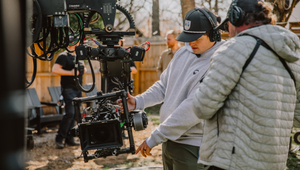
BBDO’s Heather Haley on Technical Achievements and Elegant Machines

Nashville-based production company Gear Seven pushes the limits of creativity, technology and possibility - and innovates like it’s nobody's business. Alongside a non-exclusive roster of directors and production capabilities, Gear Seven offers hardware, LED volume studios and virtual production via its sister companies Shift Dynamics and Arc Studios
Gear Seven has teamed up with LBB to speak with agency production leaders about innovations in production technology and how it’s revolutionising commercial production. This series investigates the importance of education in this area for agencies and brands and offers a fun opportunity to nerd out on all things technical, while sharing memories of their most awe-inspiring and unforgettable moments on set.
The latest interview is with Heather Haley, SVP, head of production at BBDO Atlanta. After joining in 2021, Heather has led the production side of things at the creative agency, bringing with her over 25 years of experience creating content and building brands for the likes of FCB, where she worked in Chicago for 14 years. Now leading a team of producers and creatives in Georgia’s state capital, she is applying her knowledge to a new generation of ideas and concepts, assisted by the evolving production landscape and its emerging technologies.
Speaking to LBB’s Ben Conway, Heather discusses the potential of AI and virtual production technologies, the motion control rig and drone piloting that blew her mind, and landing a plane without brakes on a glacier.
LBB> Throughout your career, what has been the most exciting or ground-breaking piece of ‘new’ kit or technology that was introduced to you and why?
Heather> I’ve seen so many remarkable technologies developed during my career, it’s hard to pick just one. As much as I love the snorkel lens, the Phantom camera, and the Bolt Motion Control Rig, my most memorable introduction to a new technology was the first time I worked with an FPV trick drone. It was a visual thrill, thanks to amazing technology and an extraordinarily talented operator.
LBB> What piece of kit (big or small and mighty) still makes you feel in awe when on set?
Heather> The speed and precision of the Bolt Motion Control Rig just blows my mind. It looks like it weighs a ton and moves like a flash. It’s such an elegant machine.
LBB> Can you talk us through one or two of the most exciting recent productions that you’ve been involved in that you think had a really interesting innovation or technological aspect to them?
Heather> The BBDO team had an interesting idea for our Bayer Crop Science client. We proposed filming a documentary that convinced growers that their dreams of a weed-free field could become a reality. Of course, the growers were sceptical.
To prove the point, we placed cameras in the fields of three farms and recorded an eight-week timelapse. The production company placed custom remote control robotic camera rigs in the middle of two corn fields. One camera was held close to the ground on a dolly and moved down a long row of corn. Another camera was mounted on a slider to capture horizontal movement. Both cameras moved only a few inches per day.
These cameras had to withstand some crazy Midwestern weather!
Our research determined that 360-degree cameras wouldn’t hold up, so we encapsulated DSLRs in all-weather housing and used solar power to keep the cameras running. We monitored the camera set-ups via a cellular network.
At the end of the eight weeks, we’d captured healthy corn growing weed-free and some pretty dramatic weather footage!
LBB> A similar question but it doesn’t have to be recent - what is the time in your career that you’ve been on set/observing a production and been particularly in awe of what the production team was pulling off?
Heather> I had the unique experience of working on a production in which we filmed a group of sled dogs running on a glacier in Alaska. One of the dogs had won the Iditarod [Sled Dog Race] the year prior. We and our small pile of equipment were the only signs of humankind in a very vast and very cold landscape.
In case that doesn’t sound like a ‘technical’ achievement, close your eyes and imagine landing an itty-bitty puddle jumper… on a glacier… without brakes.
LBB> Virtual production is growing in popularity in film and TV,, what are your thoughts about its potential in the advertising space?
Heather> It has tremendous potential in advertising, and I can’t wait to try it! I think actors’ performances are naturally much better when they’re reacting to an environment versus performing on a green screen. And I imagine it would be like having an infinite number of choices for locations! Realistic, fantastical… anything we can think of will be possible.
LBB> It can involve quite a different workflow/process - is that something you feel agencies and brands need to educate themselves on or does it lie with the production company? Why?
Heather> Both. Agency producers have a responsibility to research new technology, but we also depend on our production partners to give us guidance and tell us what’s possible. Ideally, the workflow for using the technology in the commercial venue will be a balance of fully taking advantage of the technology and meeting the schedule and budget needs of our clients.
LBB> With so many platforms to produce for, what’s your preference - to maximise assets across platforms or to produce content that’s more tailored to each platform? Or some sort of balance? What sort of conversations do you tend to have about this?
Heather> I prefer to tailor content to its target platform as frequently as possible, but that’s not always realistic within the given budget. I’m a big fan of the ‘super-shoot’, in which we capture assets for broadcast, social-digital and photography in a single (huge) production. In this situation, we can take advantage of shared talent, art department and locations, but still tailor the creative for the specific target platform.
LBB> Quite often, production involves trying to solve a problem that’s never been attempted before - and that can mean hacking existing technology or trying to find new technologies. When you get a project that has such technological challenges, how do you and your team like to approach them?
Heather> This type of project is the most fun because it takes quite a bit of investigation! First, I gather teammates and grill them regarding any relevant or related experience. Then we dive into research mode online, and I call everyone I can think of that could offer any insight. The smallest bit of insight can be a huge piece of the puzzle! Sometimes, production partners will go so far as to produce a test to try out a technique or test a hypothesis.















